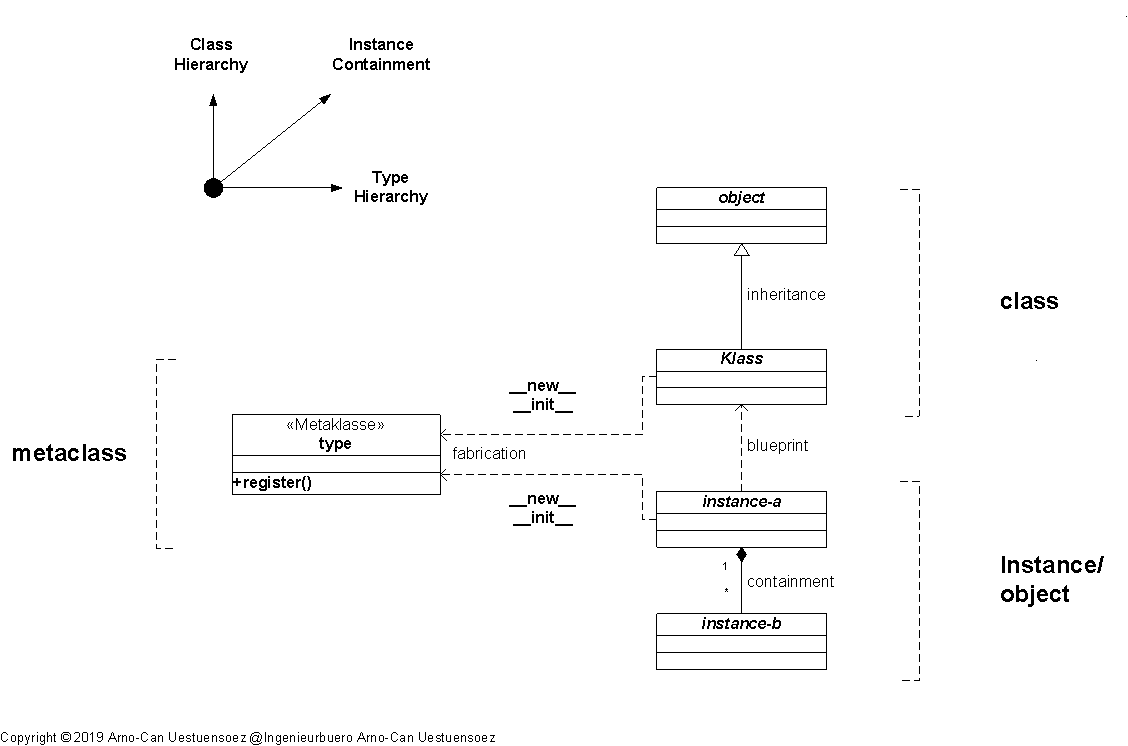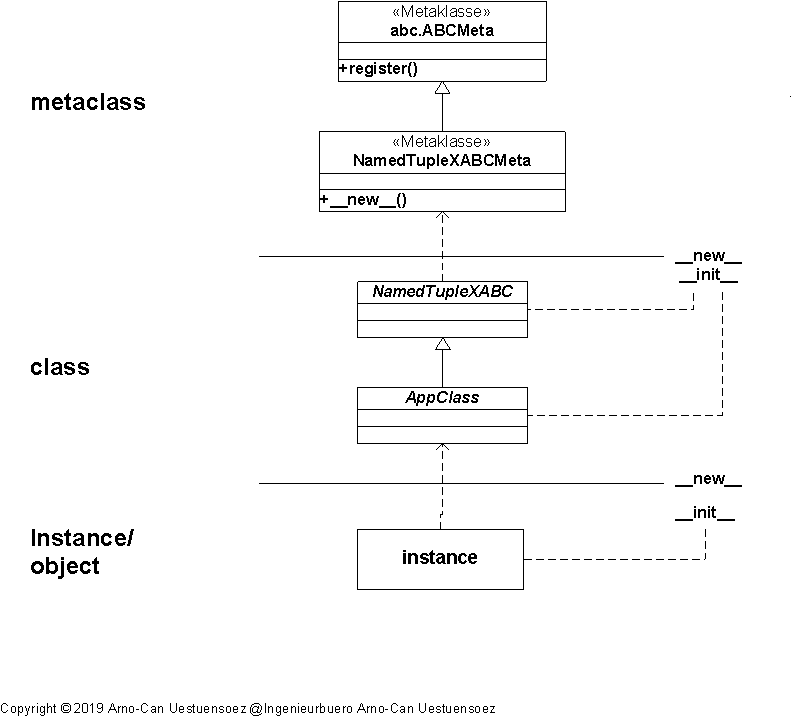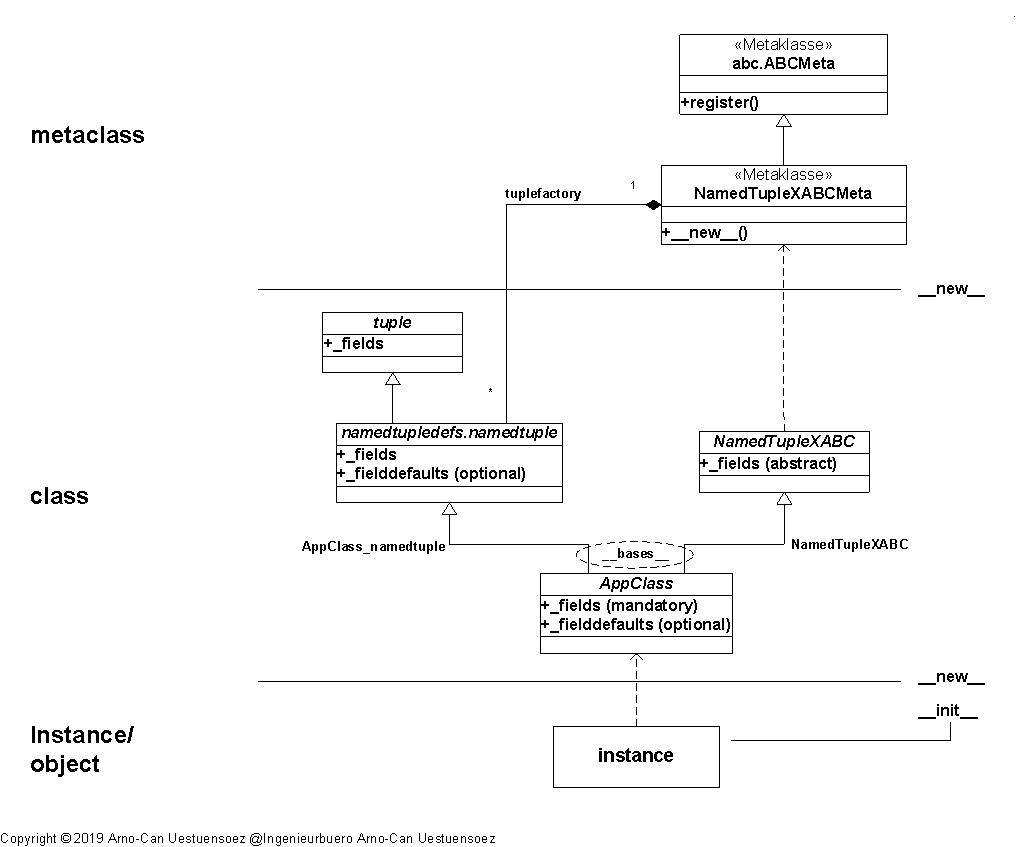5.1. The Implementation Basics of Classes¶
5.1.1. Repititorium Class Creation¶
5.1.1.1. Components of Classes¶
The classes are implemented as basic data structures containing data and references to functions to proceed the data. This basic concept is honed by various additional concepts for the actual implementation. In case of Python the most implementation details are part of the language definition. These are for example the magic functions and data members enclosed in double_underscores __<member-data-or-function>__. The most prominent disclosed implementation details for the class definition and creation are here the functions - or more approriate the methods - __new__ and __init, and the data __class__ and __bases__. The class fabric is which has created the class is either referenced by a special member __metaclass__, or could be evaluated dynamic by the call of the type function.
The data members reflect the blueprint of the inheritance structure of the class design. While in static compiled languages the blueprint has to be defined before compileation and is by default not foreseen to be altered, Python provides by concept the dynamic creation of classes at runtime. In Python the classes are actually runtime instances, which serve as a dynamic instance fabric. The actual creation is performed by the so called metaclass, either the default type, or a custom class. Thus Python discloses the complete mechanism of class and data creation with standard callbacks for user defined procedures.
5.1.1.2. Classes and Objects¶
The overall blueprint of the class definition, and the class and instance creation could be described in a model of three dimensions.
Class-Hierarcy
Type-Hierarchy
Instance-Containment
The Class-Hierarcy is defined by the abstraction model of the application. It describes the data and process flow.
The type hierarcy provides the means to implement the Class-Hierarchy into real-world programs. In most programming languages these are hidden by the compiler and though not part of the programming paradigm, Python discloses this as a standard part of the programming language.

Figure: Class and Instance Elements  ¶
¶
The Instance-Containment represents the runtime data structure to be used to process the actual data and provides the workflow to the user. The cental role in this contex is defined by the methods described in the following sections.
__init__ - for the standard development
__new__ - for the advanced development
5.1.1.3. Types of Classes and Objects¶
The basic paradigma of Python is focused on the dynamic definition and creation of its entities. This comprises the blueprint and the implementation, while the most other programming languages focus on for the dynamic runtime environment on the implementation only. The Python runtime environment provides for the dynamic class creation as well as the dynamic instance creation. Thus the classes theirselves are runtime instances.
The basic categories of runtime entities are type instances and object instances. Where the types are the fabrics for instances of type object. The instances of type object provide the basic hooks of the instance items into the the runtime framework of the Python implementation.
The actual implementation of Python has varied by different object types due to different implementation concepts and frameworks. This was finalized in the so called new object type, which also supports a specific runtime method resolution order - MRO. This is in particular established as the so called C3 linearization [C3LIN].
Resulting in the standard items:
type - as the common fabric for classes and and their instances
object - as the top level class, providing the integration of application instances into the runtime framework
Refer to the Python documentation for further details [PYLANG].
5.1.2. Call Flow of Class Creation¶
The essential criteria for the parameter design of the dynamic named tuple extension is the call flow of instance and though the custom class construction.
The basic class construction in Python comprises 3 layers of classes and objects. The metaclass is only involved in the class construction, while the instanciation of the classes are worked out by their defined inheritance hierarchy. The inheritance hierarchy serves also for the runtime resolution of method calls e.g. by the “C3 linearization” [C3LIN] - which is applied for the new object types.
This section provides yet another short overview as a reminder with some conrete example flows as required for the design of the classes NamedTupleXABC and NamedTupleXABCMeta. For a detailed overview refer to [customclass]. For a detailed article see “Understanding Python metaclasses” [IONELPYMETA].
5.1.2.1. Single Inheritance¶
The basic process flow is pretty straight forward in case of single inheritance.

Figure: Class Construction Layers  ¶
¶
Source
The following example code demonstrates the draft class structure with all __new__ and __init__ methods present.
from __future__ import print_function import abc print("0------------------------------") print() class NamedTupleXABCMeta(abc.ABCMeta): def __new__(cls, *args, **kargs): print("NamedTupleXABCMeta :new :" + str(cls) + " " + str(args) + " " + str(kargs)) return super(NamedTupleXABCMeta, cls).__new__(cls, *args, **kargs) def __init__(self, *args, **kargs): print("NamedTupleXABCMeta :init :" + str(self) + " " + str(args) + " " + str(kargs)) return super(NamedTupleXABCMeta, self).__init__(*args, **kargs) class NamedTupleXABC(object): __metaclass__ = NamedTupleXABCMeta def __new__(cls, *args, **kargs): print("NamedTupleXABC :new :" + str(cls) + " " + str(args) + " " + str(kargs)) return super(NamedTupleXABC, cls).__new__(cls, *args, **kargs) def __init__(self, *args, **kargs): print("NamedTupleXABC :init :" + str(self) + " " + str(args) + " " + str(kargs)) return super(NamedTupleXABC, self).__init__(*args, **kargs) class AppTupleClass(NamedTupleXABC): _fields = ('a',) def __new__(cls, *args, **kargs): print("AppTupleClass :new :" + str(cls) + " " + str(args) + " " + str(kargs)) return super(AppTupleClass, cls).__new__(cls, *args, **kargs) def __init__(self, *args, **kargs): print("AppTupleClass :init :" + str(self) + " " + str(args) + " " + str(kargs)) return super(AppTupleClass, self).__init__(*args, **kargs) print() print("1------------------------------") print() a = AppTupleClass() print() print("OK")
Result
Results in the output:
0------------------------------ NamedTupleXABCMeta :new :<class '__main__.NamedTupleXABCMeta'> ('NamedTupleXABC', ... # class creation parameters NamedTupleXABCMeta :init :<class '__main__.NamedTupleXABC'> ('NamedTupleXABC', ... NamedTupleXABCMeta :new :<class '__main__.NamedTupleXABCMeta'> ('AppTupleClass', ... NamedTupleXABCMeta :init :<class '__main__.AppTupleClass'> ('AppTupleClass', ... 1------------------------------ AppTupleClass :new :<class '__main__.AppTupleClass'> () {} # instance creation parameters NamedTupleXABC :new :<class '__main__.AppTupleClass'> () {} AppTupleClass :init :<__main__.AppTupleClass object at 0x7f99d6daf6d0> () {} NamedTupleXABC :init :<__main__.AppTupleClass object at 0x7f99d6daf6d0> () {} OK
Discussion
With the call flow:
Create global class definitions as objects by themselfs. These are each created and initialized completeley, because of the order each is completely defined by itself and the eventually required previous already created classes.
NamedTupleXABC:
Create - __new__
Initialize - __init__
AppTupleClass:
Create - __new__
Initialize - __init__
Create instances/objects. Each instance is created completely by walking through the upward hierarchy in the inheritance hierarchy. Resulting in combined creation following combined initialization.
Create - new
AppTupleClass
NamedTupleXABC
Initialize - __init__
AppTupleClass
NamedTupleXABC
As depicted, a metaclass itself is not created here by the applications metaclass but provided by the systems type. The application defined metaclasses serve as the class factory and create and initialize all assigned classes by calling __new__ and __init__. Here AppTupleClass and NamedTupleXABC.
The instance creation is performed along the inheritance hierarchy starting at the derived class. The applications abstract metaclasses are not involved in the instance creation calls. The call hierarchy is first processed for the creation, second for the initialization.
For the application by namedtuplex refer to Creation of the Named Tuple.
5.1.2.2. Multiple Inheritance - Mixin¶
The process flow changes when an instance of a named tuple class is taken into account. The additional named tuple class in the actual implementation is hereby created by the factory defined by tuplefactory and _tuplefactory. The created namedtuple class is the first in the list of base classes __bases__, thus called by default by the super method. The abstract class is the second in the list and is not requied to be called after instanciation anyhow.

Figure: Class Construction Layers with Mixin  ¶
¶
Source
The following example code demonstrates the draft class structure with all __new__ and __init__ methods present.
from __future__ import print_function import abc import namedtupledefs print("0------------------------------") print() _MyTuple = namedtupledefs.namedtuple('MyTuple', 'x y z', fielddefaults=(22,33)) class MyTuple(_MyTuple): def __new__(cls, *args, **kargs): print("MyTuple :new :" + str(cls) + " " + str(args) + " " + str(kargs)) return super(MyTuple, cls).__new__(cls, *args, **kargs) def __init__(self, *args, **kargs): print("MyTuple :init :" + str(self) + " " + str(args) + " " + str(kargs)) return super(MyTuple, self).__init__(*args, **kargs) class NamedTupleXABCMeta(abc.ABCMeta): def __new__(cls, *args, **kargs): print("NamedTupleXABCMeta :new :" + str(cls) + " " + str(args) + " " + str(kargs)) return super(NamedTupleXABCMeta, cls).__new__(cls, *args, **kargs) def __init__(self, *args, **kargs): print("NamedTupleXABCMeta :init :" + str(self) + " " + str(args) + " " + str(kargs)) return super(NamedTupleXABCMeta, self).__init__(*args, **kargs) class NamedTupleXABC(object): __metaclass__ = NamedTupleXABCMeta def __new__(cls, *args, **kargs): print("NamedTupleXABC :new :" + str(cls) + " " + str(args) + " " + str(kargs)) return super(NamedTupleXABC, cls).__new__(cls, *args, **kargs) def __init__(self, cls, *args, **kargs): print("NamedTupleXABC :init :" + str(self) + " " + str(args) + " " + str(kargs)) # the abc.ABC passes __init__ to type() return super(NamedTupleXABC, self).__init__() class AppTupleClass(MyTuple, NamedTupleXABC): # # The mixin is actually created by the metaclass, here defined static for demonstration # _fields = ('a',) def __new__(cls, *args, **kargs): print("AppTupleClass :new :" + str(cls) + " " + str(args) + " " + str(kargs)) return super(AppTupleClass, cls).__new__(cls, *args, **kargs) def __init__(self, *args, **kargs): print("AppTupleClass :init :" + str(self) + " " + str(args) + " " + str(kargs)) return super(AppTupleClass, self).__init__(*args, **kargs) print() print("1------------------------------") print() a = AppTupleClass(11, 22) # uses default for 'z' print() print(a) print("OK")
Result
Results in the output:
warning: Debugger speedups using cython not found. Run '"/home/acue/venv/2.7.14/bin/python2.7" "/local/hd1/home1/env/ide/eclipse/eclipse-cpp-neon-3-linux-gtk-x86_64-20171019-devops_18/dropins/PyDev 7.0.3/plugins/org.python.pydev.core_7.0.3.201811082356/pysrc/setup_cython.py" build_ext --inplace' to build. pydev debugger: starting (pid: 2857) 0------------------------------ NamedTupleXABCMeta :new :<class '__main__.NamedTupleXABCMeta'> ('NamedTupleXABC', (<type 'object'>,), {'__module__': '__main__', '__metaclass__': <class '__main__.NamedTupleXABCMeta'>, '__new__': <function __new__ at 0x7f5e2c1bee60>, '__init__': <function __init__ at 0x7f5e2c1beed8>}) {} NamedTupleXABCMeta :init :<class '__main__.NamedTupleXABC'> ('NamedTupleXABC', (<type 'object'>,), {'__module__': '__main__', '__metaclass__': <class '__main__.NamedTupleXABCMeta'>, '__new__': <function __new__ at 0x7f5e2c1bee60>, '__init__': <function __init__ at 0x7f5e2c1beed8>}) {} NamedTupleXABCMeta :new :<class '__main__.NamedTupleXABCMeta'> ('AppTupleClass', (<class '__main__.MyTuple'>, <class '__main__.NamedTupleXABC'>), {'__module__': '__main__', '_fields': ('a',), '__new__': <function __new__ at 0x7f5e2a742230>, '__init__': <function __init__ at 0x7f5e2a7422a8>}) {} NamedTupleXABCMeta :init :<class '__main__.AppTupleClass'> ('AppTupleClass', (<class '__main__.MyTuple'>, <class '__main__.NamedTupleXABC'>), {'__module__': '__main__', '_fields': ('a',), '__new__': <function __new__ at 0x7f5e2a742230>, '__init__': <function __init__ at 0x7f5e2a7422a8>}) {} 1------------------------------ AppTupleClass :new :<class '__main__.AppTupleClass'> (11, 22) {} MyTuple :new :<class '__main__.AppTupleClass'> (11, 22) {} AppTupleClass :init :MyTuple(x=11, y=22, z=33) (11, 22) {} MyTuple :init :MyTuple(x=11, y=22, z=33) (11, 22) {} NamedTupleXABC :init :MyTuple(x=11, y=22, z=33) (22,) {} MyTuple(x=11, y=22, z=33) OK
Discussion
With the call flow:
Create global class definitions as objects by themselfs. These are each created and initialized completeley, because of the order each is completely defined by itself and the eventually required previous already created classes.
NamedTupleXABC:
Create - __new__
Initialize - __init__
AppTupleClass:
Create - __new__
Initialize - __init__
Create instances/objects. Each instance is created completely by walking through the upward hierarchy in the inheritance hierarchy. Resulting in combined creation following combined initialization.
Create - new
AppTupleClass
NamedTupleXABC
Initialize - __init__
AppTupleClass
NamedTupleXABC
As depicted, a metaclass itself is not created here by the applications metaclass but provided by the systems type. The application defined metaclasses serve as the class factory and create and initialize all assigned classes by calling __new__ and __init__. Here AppTupleClass and NamedTupleXABC.
The instance creation is performed along the inheritance hierarchy starting at the derived class. The applications abstract metaclasses are not involved in the instance creation calls. The call hierarchy is first processed for the creation, second for the initialization.
For the application by namedtuplex refer to Creation of the Named Tuple.
5.1.2.3. The Structure of namedtuplex¶
Source
The following example code displays the structure as actually defined by namedtuplex. The implemented demonstration method stubs are at the same positions as the originals. The only adaptation is the callwrapper for the tuple class MyTuple of the demonstrator. Thus the callflow traces are the same.
from __future__ import print_function import abc import namedtupledefs print("0------------------------------") print() _MyTuple = namedtupledefs.namedtuple('MyTuple', 'x y z', fielddefaults=(22,33)) class MyTuple(_MyTuple): def __new__(cls, *args, **kargs): print("MyTuple :new :" + str(cls) + " " + str(args) + " " + str(kargs)) return super(MyTuple, cls).__new__(cls, *args, **kargs) def __init__(self, *args, **kargs): print("MyTuple :init :" + str(self) + " " + str(args) + " " + str(kargs)) return super(MyTuple, self).__init__(*args, **kargs) class NamedTupleXABCMeta(abc.ABCMeta): def __new__(cls, *args, **kargs): print("NamedTupleXABCMeta :new :" + str(cls) + " " + str(args) + " " + str(kargs)) return super(NamedTupleXABCMeta, cls).__new__(cls, *args, **kargs) def __init__(self, *args, **kargs): print("NamedTupleXABCMeta :init :" + str(self) + " " + str(args) + " " + str(kargs)) return super(NamedTupleXABCMeta, self).__init__(*args, **kargs) class NamedTupleXABC(object): __metaclass__ = NamedTupleXABCMeta _fields = abc.abstractproperty() class AppTupleClass(MyTuple, NamedTupleXABC): # **The mixin is actually created by the metaclass, here defined static for demonstration** _fields = ('a',) def __new__(cls, *args, **kargs): print("AppTupleClass :new :" + str(cls) + " " + str(args) + " " + str(kargs)) return super(AppTupleClass, cls).__new__(cls, *args, **kargs) def __init__(self, *args, **kargs): print("AppTupleClass :init :" + str(self) + " " + str(args) + " " + str(kargs)) return super(AppTupleClass, self).__init__(*args, **kargs) print() print("1------------------------------") print() a = AppTupleClass(11, 22) # uses default for 'z' print() print(a) print("OK")
Result
Results in the output:
0------------------------------ NamedTupleXABCMeta :new :<class '__main__.NamedTupleXABCMeta'> ('NamedTupleXABC', (<type 'object'>,), {'__module__': '__main__', '__metaclass__': <class '__main__.NamedTupleXABCMeta'>}) {} NamedTupleXABCMeta :init :<class '__main__.NamedTupleXABC'> ('NamedTupleXABC', (<type 'object'>,), {'__module__': '__main__', '__metaclass__': <class '__main__.NamedTupleXABCMeta'>}) {} NamedTupleXABCMeta :new :<class '__main__.NamedTupleXABCMeta'> ('AppTupleClass', (<class '__main__.MyTuple'>, <class '__main__.NamedTupleXABC'>), {'__module__': '__main__', '_fields': ('a',), '__new__': <function __new__ at 0x7f2f5617c050>, '__init__': <function __init__ at 0x7f2f5617c140>}) {} NamedTupleXABCMeta :init :<class '__main__.AppTupleClass'> ('AppTupleClass', (<class '__main__.MyTuple'>, <class '__main__.NamedTupleXABC'>), {'__module__': '__main__', '_fields': ('a',), '__new__': <function __new__ at 0x7f2f5617c050>, '__init__': <function __init__ at 0x7f2f5617c140>}) {} 1------------------------------ AppTupleClass :new :<class '__main__.AppTupleClass'> (11, 22) {} MyTuple :new :<class '__main__.AppTupleClass'> (11, 22) {} AppTupleClass :init :MyTuple(x=11, y=22, z=33) (11, 22) {} MyTuple :init :MyTuple(x=11, y=22, z=33) (11, 22) {} MyTuple(x=11, y=22, z=33) OK
Discussion
The call flow is the same as before, while the new call of the application class AppTupleClass is eventually present in rare cases only.
The call flow once again:
Create global class definitions as objects by themselfs. These are each created and initialized completeley, because of the order each is completely defined by itself and the eventually required previous already created classes.
NamedTupleXABC:
Create - __new__
Initialize - __init__
AppTupleClass:
Create - __new__
Initialize - __init__
Create instances/objects. Each instance is created completely by walking through the upward hierarchy in the inheritance hierarchy. Resulting in combined creation following combined initialization.
Create - new
AppTupleClass
NamedTupleXABC
Initialize - __init__
AppTupleClass
NamedTupleXABC
For the application by namedtuplex refer to Creation of the Named Tuple.